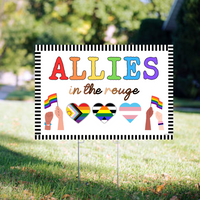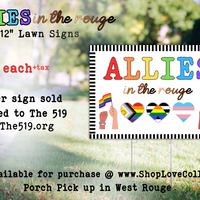


Lawn Sign, Allies in the Rouge
$20.00
- Description
** Signs will be ready for pick up the week of June 26 **
After an act of theft of some Pride Flags our neighbourhood, one thing became clear... we need MORE visibility to show how loving and inclusive residents of the Rouge are!
This double sided, thick corrugated 18" x 12" sign comes with the metal display stand. Your sign can be displayed on your lawn, or in your window.
$5.00 from each sign sold will be donated to The 519 www.the519.org
---
ALLY FLAG LEARNING
- The "A" shape represents allyship.
- The black and white stripes represent straight and/or cisgender allies.
- The rainbow colors in the "A" shape represents solidarity with the LGTBQ+ community.
PRIDE PROGRESS FLAG (& INTERSEX FLAG) LEARNING
- The Progress Pride flag features eleven primary colors, red, orange, yellow, green, indigo, violet, white, pink, blue, brown, and black.
- It incorporates five half-sized diagonal stripes that represent transgender and non-binary individuals (light blue, light pink, white), marginalized People of Color (POC) communities (brown and black), those living with AIDS and the stigma and prejudices surrounding them, and those who have been lost to the disease (black).
- A newer version of the progress pride flag was designed in 2021 by Valentino Vecchietti of Intersex Equality Rights UK, who added a yellow triangle with a purple circle (the design of the Intersex Pride Flag) to the Progress Pride Flag.
GLOSSARY
- Asexual A person who lacks sexual attraction or interest in sexual expression. An asexual person’s sexual and romantic orientations may differ (e.g. biromantic asexual), and they may have sexual and/or romantic partners.
- Biphobia The fear, hatred, or aversion of people who are attracted to more than one gender.Bisexual/BiromanticA person who is sexually and/or romantically attracted to two or more genders.
- Cisgender A person who identifies with the gender they were assigned at birth.
- Gay A person who is sexually and/or romantically attracted to people of their same sex or gender identity. Traditionally this identity was reserved for men, but it has been adopted by people of all gender identities.
- Gender-fluid A person whose gender identity varies over time and may include male, female and non-binary gender identities.
- Heterosexual/Heteroromantic A person who is sexually and/or romantically attracted to people of a different gender than themselves.
- Homophobia The fear, hatred, or aversion of people who experience same-sex attraction.
- Homosexual (*no longer commonly used in English)This term is no longer in common use. See “gay” and “lesbian”. The term homosexual has fallen out of favour as it is associated with the historic medical understanding of same-sex attraction as a mental illness. However, equivalents of “homosexual” are commonly used in French and other languages.
- Intersex An umbrella term to capture various types of biological sex differentiation. Intersex people have variations in their sex characteristics, such as sex chromosomes, internal reproductive organs, genitalia, and/or secondary sex characteristics (e.g. muscle mass, breasts) that fall outside of what is typically categorized as male or female.
- Lesbian Typically a woman who is sexually and/or romantically attracted to other women.
- Non-Binary (also ‘genderqueer’). Referring to a person whose gender identity does not align with a binary understanding of gender such as man or woman. It is a gender identity which may include man and woman, androgynous, fluid, multiple, no gender, or a different gender outside of the “woman—man” spectrum.
- Pansexual A person whose choice of sexual or romantic partner is not limited by the other person's sex, gender identity or gender expression.
- Queer Historically a derogatory term used as a slur against 2SLGBTQI+ people, this term has been reclaimed by many 2SLGBTQI+ people as a positive way to describe themselves, and as a way to include the many diverse identities not covered by common 2SLGBTQI+ acronym.
- Questioning A person who is uncertain about their sexual orientation and/or gender identity; this can be a transitory or a lasting identity.
- Gender Dysphoria A medical diagnosis often required by health providers and/or health insurance plans before prescriptions for hormones or gender affirming surgeries will be provided. It can be understood as discomfort or distress experienced by a person who feels their sense of their gender identity differs from their body, based on societal expectations.
- Gender Expression Gender expression refers to the various ways in which people choose to express their gender identity. For example: clothes, voice, hair, make-up, etc. A person’s gender expression may not align with societal expectations of gender. It is therefore not a reliable indicator of a person’s gender identity
- Gender Identity Internal and deeply felt sense of being a man or woman, both or neither A person’s gender identity may or may not align with the gender typically associated with their sex. It may change over the course of one’s lifetime.
- Sexual Orientation Romantic and sexual attraction for people of the same or another sex or gender.
- Transgender(also ‘trans’). A person whose gender identity differs from what is typically associated with the sex they were assigned at birth.
- Transphobia The fear, hatred, or aversion of people whose gender identities differ from the sex they were assigned at birth.
- Transsexual (*no longer commonly used)This term is no longer in common use, though may be more frequently used by transgender individuals of an older cohort. The term defines a person whose gender identity differs from their sex assigned at birth and who has undertaken gender affirming medical and/or surgical interventions. The term has fallen out of favour as it implies that physical transition is necessary in order to claim a trans identity.
- Two-Spirit (also Two Spirit or Two-Spirited). An English term used to broadly capture concepts traditional to many Indigenous cultures. It is a culturally-specific identity used by some Indigenous people to indicate a person whose gender identity, spiritual identity and/or sexual orientation comprises both male and female spirits.



